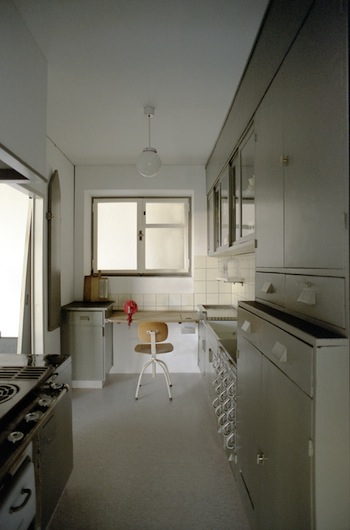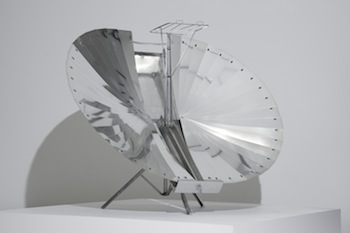The Museum of Modern Art could not have picked a better moment to mount Counter Space: Design and the Modern Kitchen, an exhibition about the changing aesthetics and politics of this domestic space. The kitchen, once considered woman’s domain and the bane of her existence, is still, after all these waves of feminism, a hotbed for contention. This year, the blogosphere has been abuzz with talk of sexism in the culinary arts; a rising “feminist food revolution” in the United States; and heated debate about whether second-wave American feminism ruined the family meal by “denigrating foodwork” and encouraging women to leave the kitchen. Counter Space has clear feminist leanings, but rather than regurgitate the usual rhetoric or play up the trope of the kitchen as domestic prison, the curators have elegantly balanced metaphorical apron strings with objects of unbridled creativity.

Tom Wesselmann, "Still Life #30", 1963. Oil, enamel and synthetic polymer paint on composition board with collage of printed advertisements, plastic flowers, refrigerator door, plastic replicas of 7-Up bottles, glazed and framed color reproduction, and stamped metal, 48 1/2 x 66 x 4 in. The Museum of Modern Art, New York. Gift of Philip Johnson. © 2010 Tom Wesselmann/Licensed by VAGA, New York, NY
Counter Space is drawn entirely from the museum’s collection, and organized in conjunction with their newest publication Modern Women: Women Artists at The Museum of Modern Art. The show recognizes women’s contributions to the kitchen as domestic workers, as well as disciplined artists, architects and designers. The icing on the cake, so to speak, is the diverse selection of works by women and men, contemporary and historical. In Martha Rosler’s iconic video Semiotics of the Kitchen (1975), an “anti-Julia Child” names and demonstrates the tools of her oppression. At one point, she jabs her knife in the air with more anger than finesse. Two aprons by Fluxus artist George Maciunas hang overhead: one is a cropped photograph of a nude woman’s backside, and the other is a drawing of human intestines. Clips from popular films that portray the kitchen as warm and welcoming run counter to a set of darkly comedic photographs by Philip-Lorca diCorcia in which the space appears nightmarish and his subjects like zombies.
Clean Formica surfaces and neatly stacked Tupperware could have easily sealed this exhibition’s demise; design shows seem to live and die by severe simplicity. Yet Counter Space feels as varied as Bed, Bath & Beyond and in some ways as functional as my own kitchen. There’s a sense from the crowded walls and shelves that everything you need to prepare a meal is right at your fingertips. It helps that the museum’s café is located just outside.

Margarete Schütte-Lihotzky, Frankfurt Kitchen from the Ginnheim-Höhenblick Housing Estate, Frankfurt am Main, Germany (reconstruction), 1926–27. Various materials, 8’9" x 12’10” x 6’10" in. The Museum of Modern Art, New York. Gift of Joan R. Brewster in memory of her Husband George W.W. Brewster, by exchange and the Architecture & Design Purchase Fund.

Dr. Adnan Tarcici, Solnar Tarcici Collapsible Solar Cooker, c.1970. Aluminum, open: 21 x 34 x 43" in. The Museum of Modern Art, New York. Gift of the designer.
MoMA’s recently acquired “Frankfurt Kitchen,” designed by Margarete Schütte-Lihotzky following World War I, is the show’s inspiration and centerpiece. Schütte-Lihotzky’s design exemplifies industrial attempts at modernizing the home using the latest advances in technology. The “labor-saving” and “leisure time” propaganda that came along with these kitchens was seen by feminists as a way to reinforce “the physical and psychological isolation of women in the home.” Some fifty year later, critical reception of Virgilio Forchiassin’s uber modern fully-equipped portable kitchen on casters would reflect changing family dynamics. Critics took Forchiassin’s compact living space (remarkably similar to the work of Andrea Zittel) as a sign of “not, perhaps, the immediate death of the nuclear family—but certainly a substantive critique of it.”
Twentieth-century developments in science and modern design also manifest in kitchen utensils and appliances, which are abundantly displayed in Counter Space. Spoon straws made famous by 7-Eleven slurpees, and plastic foods manufactured in Japan mingle with sophisticated teakettles, salad baskets, and casserole dishes. Futuristic serving bowls made of transparent acrylic recall the flying cars of The Jetsons, and the Solnar Tarcini Collapsible Solar Cooker looks like it belongs to the world of molecular gastronomy if not another world altogether.

Irving Penn, "Frozen Foods, New York", 1977. Dye-transfer print, printed 1984. 23 9/16 x 18 3/8 in. Gift of the photographer.
Depictions of frozen, fake and raw foods color the perimeter walls, appearing in photographs by William Eggleston, and Irving Penne, a mildly psychedelic depiction of egg yolks by James Rosenquist, and a kitschy relief painting by Tom Wesselmann, an overwhelmingly pink interpretation of the American kitchen. Andy Warhol’s Campbell’s Tomato Soup Juice Box (1964), and Heinz Tomato Ketchup Box (1963-4) sit just underneath. Old kitchen commercials projected on nearby monitors remind not only of Warhol’s early work in food industry advertising, but also the role that television played in selling modern design and changing the American home.
Once upon a time, it would have been hard to imagine reclaiming the kitchens that earlier generations of women tried so hard to get of. Counter Space shows us that some things about this space are definitely worth holding on to.
Counter Space is on view through March 14, 2011. The public is invited to submit a recipe for a dessert competition, and the winner will have the opportunity to prepare the dessert with Executive Chef Lynn Bound of the Art Food Cafes. Visit the website for more information.




Pingback: Tuesday links | Tyler Green: Modern Art Notes | ARTINFO.com
Pingback: Gastro-Vision: Back in the Kitchen « Extracts